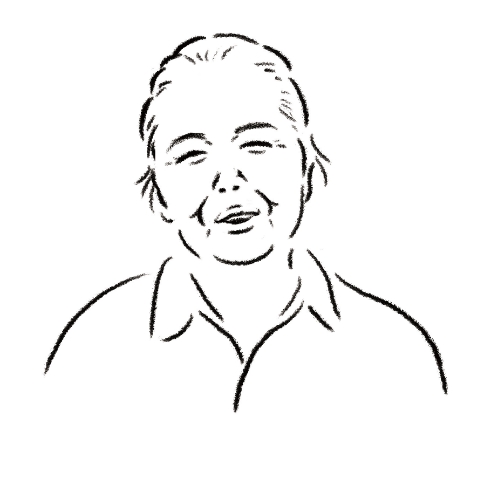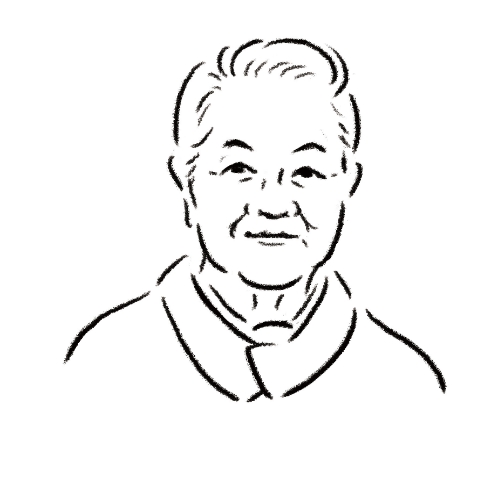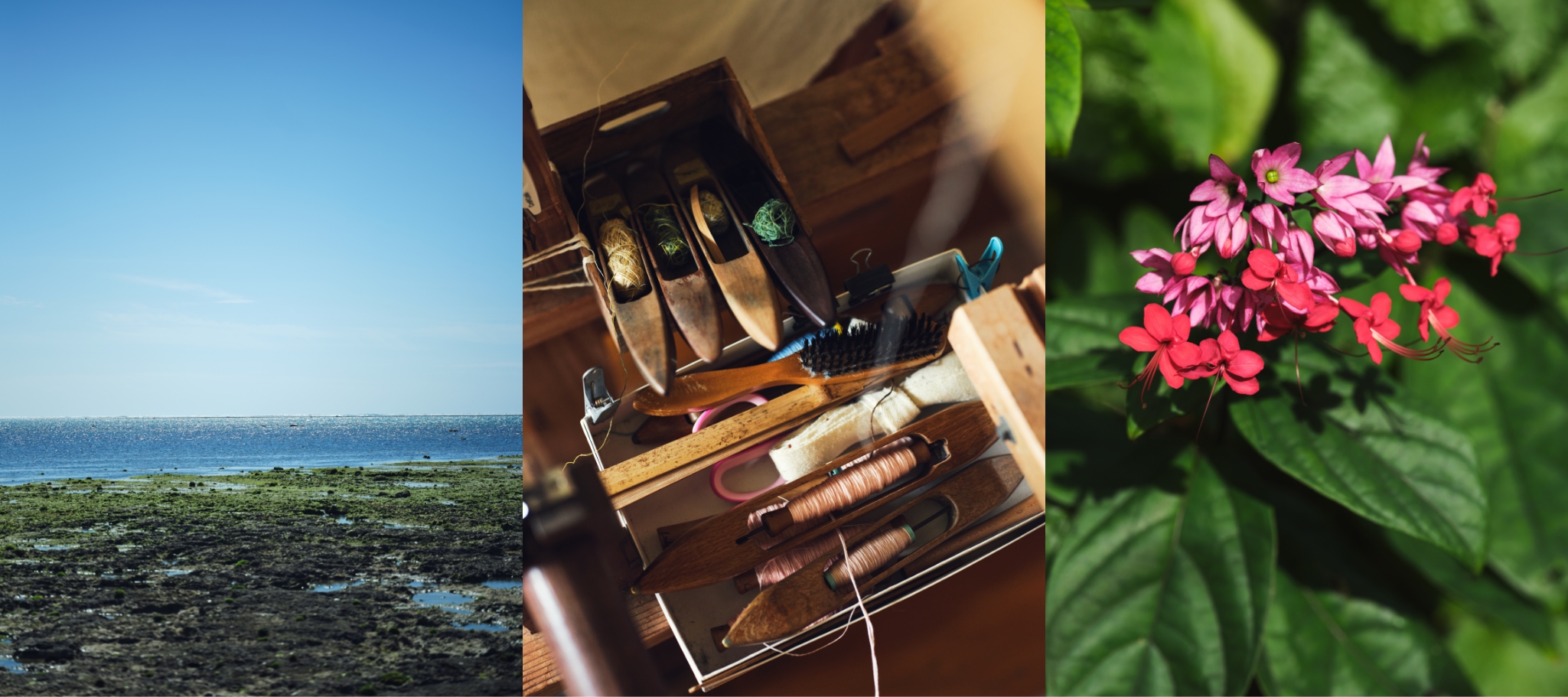YAMATO
Interview with a creator of Minsa
May 4th is Minsa Day
Interview with a creator of Minsa and Yaeyama Jofu Kimiko Matsutake
Born on January 10, 1958

Kimiko Matsutake is always full of energy. She runs a dyeing and weaving studio “Nawata”, located in Shiraho, Ishigaki City, Okinawa Prefecture.She creates both the hand-woven Minsa Obi that use 100% natural dyes as well as, Yaeyama Jofu which has a cool texture and is woven with thread spun from Ramie, which grows naturally in Okinawa. Ms. Matsutake is well-described as cheerful and lively. In this interview we will explore her charm which makes people around her feel more positive and uplifted.
-Interviewer : How did you get started with Minsa?
Matsutake: My hometown, Ishigaki Island, is known as the “island of performing arts” and has many traditional arts and crafts, and Minsa was one of them. I used to casually watch local grandmothers weaving, but when I was a high school student away from my hometown, I realized the appeal of this art. This island has a variety of colors and traditions that allow each artisan to utilize their sensibilities. I wanted to contribute to the island, so I returned to my hometown of Shiraho and started weaving.
-Interviewer : What kind of child were you as a child?
Matsutake: I was, and still am, a child who has never stopped talking. My mother always told me to be quiet and not to talk, and when I got on the bus, I would talk to any senior women I didn’t know. I didn’t understand “shyness”, and I had many friends. I also always loved art and wanted to become a manga artist. I was commissioned by my friends to draw bromide pictures of celebrities that were popular at the time.
-Interviewer : Do you have any kind of daily routine?
Matsutake: I get up at 5 a.m. every morning to deliver newspapers. I spend an hour delivering to 79 residences in the vicinity of my home. Originally my sons were doing this job, and I helped out when they were injured or sick. When they got jobs, I asked “Can I do it?” So, I took over that job. I can move my body in the morning, which gives me a quick boost. At night, I go to bed around 11pm. Five and a half hours of sleep is enough for me, and the movement of the stars in the morning reminds me of the changing of the seasons.
-Interviewer :
You are always powerful, Ms. Matsutake, but what is the source of your energy?
Matsutake: I absolutely love my current job. I want to devote all my time to it. I love making things, I love weaving, and although I wasn’t wealthy, I never felt like I was suffering. No matter how difficult the job may seem, I want to see myself able to do it. I also like myself when I’m working towards a goal, and it’s fun when I end up achieving it, and when I don’t achieve a goal, the frustration becomes my drivingforce. I wonder if this way of thinking of mine is similar to a kind of sports spirit, and when I see an active athlete, I feel a great deal of empathy and excitement.
-Interviewer : So you really love your job.
Matsutake: “Work = Hobby = What I love”. I’m grateful to be able to do what I love. I never say “I can’t do it”. When someone asks me, “Can you do it?” I answer, “ There’s no reason I can’t do it! I’ll do it.” I think that everyone has the same skills, and I think, “Why don’t you do it if you can?” I opened this workshop at the age of 55, and at that time, I got a loan from the bank, and I took on the challenge myself. I had friends and business partners who followed me there, and I’m working here now.
-Interviewer : Do you have some wishes for the future of Minsa?
Matsutake: It’s traditional fabric that has been in existence for a long time. We would like to tell everyone “Minsa is a traditional fabric.” The fabric can change depending on the sense of artisans or weavers. That’s one of Minsa’s fascinating aspects. The resulting fabric is not a product of a “division of work”, but everything for one piece of fabric is done by one person. So I think you can see each weaver’s character through the finished fabric. I’m looking forward to seeing what changes occur in the future, and I want to be able to tell children, “It was like that in the past”.
-Interviewer : Is there anything you would like to say to the people who wear yourclothes?
Matsutake: If you could just give some thought to whom the creator might be, that’s good enough. I love handmade things. So, whenever I see one, I think about it and try to feel the time and thought that was put into making it. I also always wonder “Who made it, and where did they make it?”, and “What kind of person made it?”. By doing this, I feel like I can connect with the person who has created the product. I would behappy if others would give some thought about the creators and their creations, even if for a moment, like I do.
Interview with a creator of Taketomi Minsa Yumiko Shimanaka
Born on January 23, 1948

“Taketomi island”, located 15 minutes by ferry from Ishigaki island, is famous as a tourist destination surrounded by beautiful nature, but it is also a place where traditional “Minsa” fabrics are made. Yumiko Shimanaka lives there. She is the Chairperson of the “Taketomi Textile Cooperative Business Association” which has production bases on Taketomi island and Iriomote island. Also, she has been an active Minsa Weaver(artisan) for almost 50 years. We interviewed the gentle and humble Ms. Shimanaka, and she told us about Taketomi island and the charm of Minsa.
Interviewer: Speaking of Taketomi, that is a place people always long to visit.
Shimanaka: Taketomi island has few popular places, but this whole island was selected as a “Preservation Districts for Groups of Traditional Buildings” area. The red-tiled houses on the island are followed by white sand pathways, and coral reef stone walls are covered with Bougainvillea, Hibiscus and other flowers all year round.
The island is also rich in traditional events and festivals throughout the year, which we, the islanders, carefully protect and pass on. I believe that the richness of the people’s lives is due to their cooperation with each other in the spirit of “Utsugumi (“collective cooperation” in the dialect of Taketomi)”.
Interviewer: What was your Childhood like?
Shimanaka: I was not much of a talker, and I was not good at speaking in public.
I had five siblings, so we all worked together as a family to make a living. Bashofu (cloth of Musa basjoo) was also woven on Taketomi Island, and my grandmother used to weave the thread for it, so we often went to cut the basho trees together. I helped with weaving from a very young age, and the weaving process was something I was familiar with.
Interviewer: Why did you start to weave?
Shimanaka: Originally, my family had been weaving since I was very young. So, it was very familiar to me. I have three children. When the youngest child went to kindergarten, I thought, “I wonder if I should try to weave.” Taketomi is a small island, but in the past, everyone weaved, and when I walked on the road, I could hear the sound of weaving. My grandmother and mother were also weaving, so I naturally chose to do the same.
Interviewer: What section of Minsa’s manufacturing do you like?
Shimanaka: All of them!
Taketomi has a lot of blessings of nature. So, I like the fact that I can dye threads various colors. It is also interesting to weave while imaging different ideas and patterns in my head. However, I can’t always weave a fabric as I have imagined, and I find that I am often times not satisfied with my results. However, I really enjoy the time of trial and error, thinking “I’ll do it this way next time!”. I am especially particular about the weft. Even if I use one color for the warp, I find I want to change the weft as I weave. Even though I know it is easier to weave with one color, I want to add color and enjoy the result.
Interviewer: Do you have a favorite dye among herb dyes?
Shimanaka: Especially, I like indigo. We grow Yaeyama tree indigo, which we crop and grow in indigo jars, that is a jar for storing indigo dye. Indigo changes its condition day by day, which affects its color. Creating this dye takes a lot of time and effort, but I am truly attracted to and love this dye a lot. Now my daughter does the dyeing, and I do the pre-step work and so on, making things together with my family. There is a brown dye called “kuru” (Dioscorea cirrhosa) in Iriomote Island, and the colors that can only be dyed there is also quite appealing.
Interviewer: Do you have any thoughts for the wearer?
Shimanaka: In Taketomi, everyone wears the woven fabrics for island events, but there are some concerns about having other people wear them. For example, will they like it, how comfortable is the fastening, etc. I’m concerned about many different things because I’m worrier. However, when I see someone who is wearing a Minsa, I am so happy, “It’s Taketomi Minsa!
Interviewer: What is your wish for the future of Minsa?
Shimanaka: Taketomi Minsa is woven in three districts: the eastern and western parts of Iriomote Island and Taketomi Island. The number of weavers (artisans) has been decreasing in recent years, so I would be happy if even one or two people from the younger generation would inherit the skill. There are not many weavers on Taketomi Island, so I have been greatly supported by the young people on Iriomote Island, who have been working very hard to learn this art. Some people have even moved from the mainland and joined the labor association, and because of this, we have been able to create things together. People weave with their own style using the colors derived from the nature of Taketomi Island and Iriomote Island. I am very grateful to those who find Minsa attractive, create them, and wear them. This is why I sincerely hope that this flame never dies out.
Thank you, I appreciate it.
Translated by:
Miyu Nakayama, Yoshino Sugiyama, Yuina Akaiwa, Gaku Shoda, Yuki Yamaguchi, Tomoka Yasuda, Nanase Yanai, Ai Yoshida, Sato Oishi, Noa Sasaki, Souta Machii, Kai Fukuda, Yuiko Kunii, Daiki Mishima, Koudai Takise, Mao Kurokawa, Miyu Ogino, Honoka Sumita, Miku Tanaka, Department of Tourism and Transnational Studies, Faculty of Foreign Languages, Dokkyo University.


